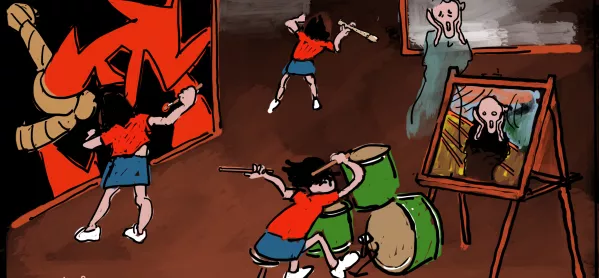Our pop-up gallery is ready and the exhibition declared open. Children have selected the very best of their abstract paintings and displayed them for all to see. But the viewing public are expected do more than admire these works of art, they are challenged to determine which piece of classical music each one represents. With the titles of the music and excerpts from each piece readily available, it should be an easy task.
Mina’s picture catches the eye in the same way that a motorway pile up catches the eyes of drivers on the opposite carriageway. The colours she has used are exclusively red and black and the lines are either fiercely jagged or tangled up into intense knots. Clearly it has been painted at a furious pace with an energy that punches the viewer in the eye.
Mina’s artwork seldom gets put on display, not because her teacher thinks it doesn’t deserve to be celebrated, but because it rarely survives the creative process. Last week she tore up her observational sketch of an old trainer and stamped on it because it looked like a stupid fat beetle. But maybe this says more about Mina’s ability to control her feelings than her ability to control a pencil.
Her personal background is an emotionally unstable one. Her life is mostly drawn in shades of red and black, and is characterised by jagged lines and intractable knots. It is a life that frequently gets torn up, stamped on and punched in the face. That is why our music teacher suggested the idea of combining art and music in a way that would help children explore their emotions.
Mina’s relationship with music (like her relationship with art) is complex and unpredictable. She has joined the choir several times but either quit or been thrown out shortly afterwards. Her brief foray into learning an instrument ended with a recorder sitting in resolute silence on the school roof following a fierce disagreement she had with it over the correct fingering for Merrily We Roll Along.
“You’ll be pleased to know this lesson requires no artistic talent, no musical ability, and that there is no right or wrong way of doing it,” said the music teacher. Then she played three different pieces of music, each time asking the children to paint whatever colours, patterns and shapes came into their heads while they listened. She did not tell them the pieces were Mars, Bringer of War; Venus, Bringer of Peace; and Jupiter, Bringer of Jollity by Gustav Holst, until afterwards.
Everyone agrees that (probably because of its violent intensity) the most eye-catching picture on display is Mina’s. What they don’t know is that she painted it while listening to Venus. Her Mars inspired piece lost the battle and is currently languishing in the recycling, while the demise of Jupiter was anything but jolly.
“Next week I’ll bring in a selection of musical instruments and let the children compose soundscapes to three emotionally different works of art,” says the music teacher. I smile as I imagine what Mina might do with several large percussion instruments and a copy of Edvard Munch’s The Scream.
Steve Eddison is a teacher at Arbourthorne Community Primary School in Sheffield




